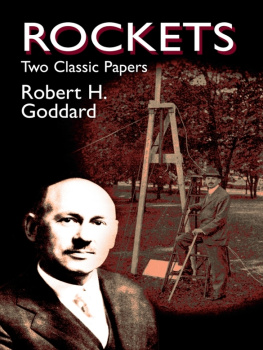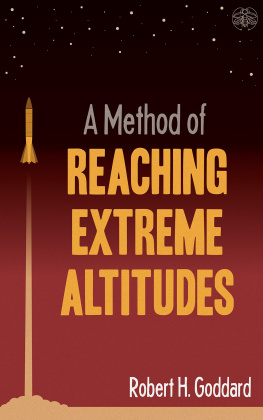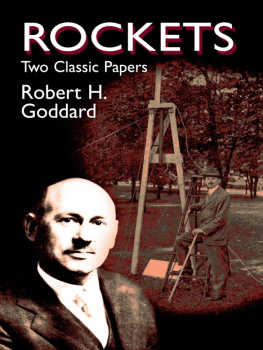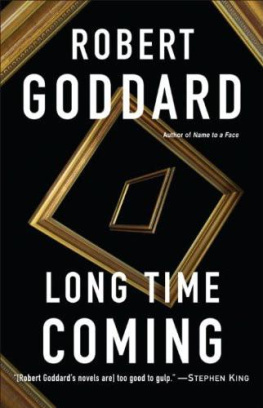Robert Goddard - Rockets
Here you can read online Robert Goddard - Rockets full text of the book (entire story) in english for free. Download pdf and epub, get meaning, cover and reviews about this ebook. year: 2012, publisher: Dover Publications, genre: Children. Description of the work, (preface) as well as reviews are available. Best literature library LitArk.com created for fans of good reading and offers a wide selection of genres:
Romance novel
Science fiction
Adventure
Detective
Science
History
Home and family
Prose
Art
Politics
Computer
Non-fiction
Religion
Business
Children
Humor
Choose a favorite category and find really read worthwhile books. Enjoy immersion in the world of imagination, feel the emotions of the characters or learn something new for yourself, make an fascinating discovery.
- Book:Rockets
- Author:
- Publisher:Dover Publications
- Genre:
- Year:2012
- Rating:5 / 5
- Favourites:Add to favourites
- Your mark:
- 100
- 1
- 2
- 3
- 4
- 5
Rockets: summary, description and annotation
We offer to read an annotation, description, summary or preface (depends on what the author of the book "Rockets" wrote himself). If you haven't found the necessary information about the book — write in the comments, we will try to find it.
Rockets — read online for free the complete book (whole text) full work
Below is the text of the book, divided by pages. System saving the place of the last page read, allows you to conveniently read the book "Rockets" online for free, without having to search again every time where you left off. Put a bookmark, and you can go to the page where you finished reading at any time.
Font size:
Interval:
Bookmark:

DR. ROBERT H. GODDARD
ROBERT HUTCHINGS GODDARD was born in Worcester, Mass., on October 5, 1882. His early schooling was obtained at Boston. where he lived with his family until he was sixteen. His college work was taken at Worcester, where he was graduated from the Worcester Polytechnic Institute in 1908.
Upon graduation, he obtained a position at Worcester Polytechnic Institute as an instructor in physics. He continued to be connected with the academic world until 1943, part of the time on leaves of absence. His teaching career was conventional, rising in the usual steps from instructor to assistant professor and finally to full professor at Clark University. During a small part of this period, in the 1912-1913 season, he served as research fellow at Princeton University. The rest of his academic career was passed in Worcester.
In his school days Goddard enjoyed mathematics, and was fond of studying better ways to do things. In his freshman year at college one of his professors assigned the topic Traveling in 1950 as a theme subject. Goddard produced a bold paper in which he described in detail a railway line between Boston and New York, in which the cars were run in an evacuated tube and were prevented from metal-to-metal contact with the guide rails by electromagnets. With such a vacuum railroad he calculated it would be possible to make the run from New York to Boston in ten minutes.
As a young professor of physics, Goddard made contributions of importance on the conduction of electricity from powders, the development of crystal rectifiers, the balancing of airplanes, and the production of gases by electrical discharges in vacuum tubes. During his fellowship in Princeton, he produced the first laboratory demonstration of mechanical force from a displacement current in a magnetic field; this current being the fundamental concept in Maxwells theory of electromagnetic waves (radio).
These achievements, however, were merely tune-ups for the real accomplishments of his life, which were soon to begin. There is apparently no record of the first experiments he made with rockets, though it is known that this work began as part of a search for practical means of sending meteorological instruments into the stratosphere. To friends, Dr. Goddard once described with amusement some static tests he made as early as 1908 with small rockets in the basement of Worcester Polytechnic Institute. His experiments filled the basement of the building with acrid smoke, and so disturbed the equanimity of the institution that he was asked to desist, at least until better equipment could be provided.
It was during his brief period at Princeton in 1912 that he made the initial computations which later were to form the basis of the Smithsonian paper of 1919. In this period, when he was about thirty, the great excitement of discovery first began to come upon him, for his calculations clearly indicated that only a little fuel, relatively, would be required to lift a payload to really great heights by rocket power, provided the rocket were so constructed as to make use of the fuel effectively.
Upon returning to Clark, in 1914, he began to experiment in earnest, beginning with ship rockets, and continuing with rockets of various types manufactured by himself. By 1916 he had reached the limit of what he could do on his own resources. Inexperienced though he was in the ways of money-raising for scientific research, his earnestness and enthusiasm won respect and attention. When he presented his idea on paper to the Smithsonian Institution that year he promptly received a letter from Dr. Charles D. Walcott, then secretary of the Institution, commending him on the report and inquiring how much money would be needed.
Goddard guessed it would require $10,000, but cautiously asked for $5,000. Between that day in 1916 and the appearance of his first paper in 1919, the experimental work required a total of $11,000, the whole sum of which was made available by the Smithsonian. This was the investment that launched modern rocketry and jet propulsion.
The rest of Goddards achievements are told, factually, in the two reports republished in this book. What is not disclosedwhat can never adequately be toldis the labor and persistence and thought and heartbreak that went into these accomplishments, through which Goddard fathered all the research and development which led to the great expansion of jet propulsion in World War II; which continues to grow and unfold today in the jet propulsion research achievements of peace.
In 1924 Goddard married Esther Christine Kisk, who had been associated with him in his work, and who continued after their marriage to play a large part in the continuance of his research. He frequently ascribed to her the courage and faith which made his continuing efforts possible. Among other things, she was the official photographer of his tests. It was her camera that produced the pictures which illustrate his second report.
After the entry of the United States into the first World War in 1917, Goddard volunteered his services, and was set to the task of exploring the military possibilities of rockets. He succeeded in developing a trajectory rocket which fired intermittently, the charges being injected into the combustion chamber by a method similar to that of the repeating rifle. He also developed several types of projectile rockets intended to be fired at tanks or other military objectives, from a launching tube held in the hands and steadied by two short legs, a device similar in many respects to the bazooka of World War II.
These weapons were demonstrated at the Aberdeen Proving Grounds on November 10, 1918, before representatives of the Signal Corps, the Air Corps, the Army Ordnance and others. The demonstrations went off quite successfully, but the Armistice next day put an end to the war and also to the experiments.
In the Second World War Goddard likewise volunteered his services, and was engaged in liquid fuel rocket research for the Navy at Annapolis throughout the conflict.
Goddard concluded his last report, in 1936, with these words: The next step in the development of the liquid-propellant rocket is the reduction of weight to a minimum. Some progress along this line has already been made.
Part of this progress consisted of the development of ingenious, light-weight, simple fuel pumps for injecting the propellants rapidly into the liquid-fuel rocket motor. The physicist had expected to return to New Mexico as soon as possible after the War, to continue his work on high altitude rockets, and planned to set some altitude records which would have been spectacular indeed.
His death, at the age of 62, brought this program to an untimely end. Nevertheless, Goddard lived to see the dream of his youth become reality. Jet propulsion, at least for the uses of war, matured in his lifetime from a fantastic notion into a billion-dollar industry. It gave promise, too, of achieving the objectives of peacetime research for which he had spent a lifetime of thought and effort.
Dr. Goddard had been a member of the American Rocket Society for many years, and a few months before his death was elected to the Societys Board of Directors. He was universally beloved and respected, and especially so by his associates in research on rockets and jet propulsion. The Board of Directors of the American Rocket Society paid tribute to him in these words:
With the death on August 10, 1945, of Dr. Robert H. Goddard, American science has lost one of its greatest pioneersthe creator of the modern science of rocketry.
Font size:
Interval:
Bookmark:
Similar books «Rockets»
Look at similar books to Rockets. We have selected literature similar in name and meaning in the hope of providing readers with more options to find new, interesting, not yet read works.
Discussion, reviews of the book Rockets and just readers' own opinions. Leave your comments, write what you think about the work, its meaning or the main characters. Specify what exactly you liked and what you didn't like, and why you think so.

